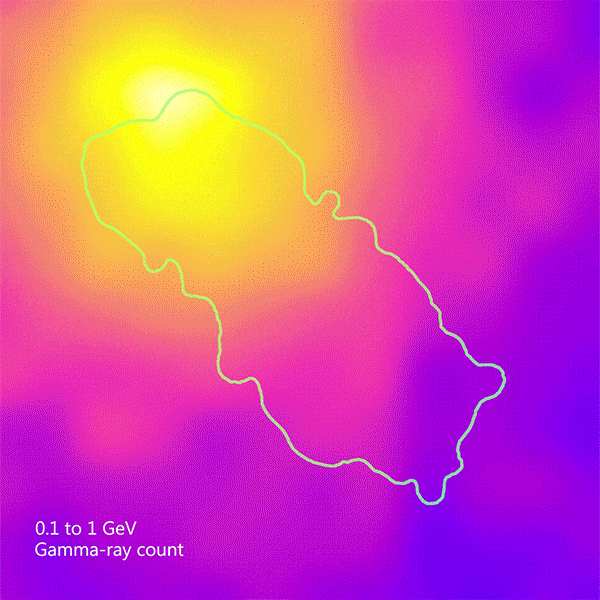NASA’s Fermi satellite has finally sewn together a lineage of 12 years worth of data compiling a study of old stellar bones: G106.3+2.7. Outside the tough-to-remember name, the team of scientists was able to track down why and where some of these intense cosmic rays are originating. We finally have an answer for one of the many parts of this question: a bygone supernova.
G106.3+2.7 is an ancient shipwreck of a star, it’s about 2,600 light-years away in the constellation Cepheus. Now, it’s just dust in the stellar wind.
But before we get into more of that, it’s first important to know some history into how the Fermi satellite got its name.
Enrico Fermi is the pioneer of nuclear physics. Some say it was Albert Einstein, but the Romans once again proved astounding innovators in history. Born in Rome, Fermi was (and will be a cornerstone in all nuclear sciences) an influence on the comprehension, application, understanding of quantum physics, and theoretical applications.
Fermi escaped with his Jewish wife to the United States after murderous Italian racial laws were instituted by the Fascismo Italiano or the fascist Kingdom of Italy’s government from 1922-1943. With this, he brought to the world the first nuclear reactor and was involved with the history-altering Manhattan Project.
The first nuclear chain reaction was achieved just outside Chicago in Stagg Field, some twenty miles away from Chicago, on University of Chicago premises under strict secrecy. Not only was it a “long drive” to score a field goal in nuclear physics, many gaffs and fake projects were also simulated to hide the true nature of Fermi’s work and his teams. Originally, the plan called for a hide-under-the-nose approach and building the reactor in the center city of Chicago. Obviously (and thankfully), this didn’t happen. In 1942 the world was greeted by the first nuclear reactor blanketed in thick, heavy bricks of graphite and welcomed by apprehensive albeit happy scientists.
Sadly, Dr. Fermi passed at the incredibly early age of 53 after an experimental stomach cancer surgery. The world was robbed of one of its most brilliant minds of time immemorial.
It’s no surprise then that Dr. Fermi lives on in the very satellite named after him gauging you’ll never guess what: cosmic gamma rays.
Fermi Satellite’s Most Recent Major Discovery
The Fermi satellite shows that the explosions of stars propel all these cosmic particles, in particular gamma rays, up to or beyond lightspeed. It’s fairly impossible at the time to determine the origins for certain swathes of gamma rays but, when these protons collide with cosmic gasses they produce the tell-tale gamma ray lighting.
This delightful light show is precisely what Fermi shows us, giving rise to potential answers and new questions.
“Theorists think the highest-energy cosmic ray protons in the Milky Way reach a million billion electron volts or PeV energies,” says Ke Fang, an assistant professor of physics at the University of Wisconsin, in a statement. “The precise nature of their sources, which we call PeVatrons, has been difficult to pin down.”
Thanks to chaotic magnetic waves and irregularities that abound, eventually these particles gain so much speed they cannon off into the universe at ridiculous speeds. The particles’ only limiters are the magnetic wave edges themselves. Once they seem ready to escape at tremendous speeds they bounce back and forth like a stellar match between tennis legends Serena Williams and Roger Federer. At some point, they gain enough speed to finally spike “out of the court” and into the cosmic sea. Call that 60-Love.

Giving a slightly comparable idea: boosted to about 10 times the energy used by the Large Hadron Collider, PeV protons are on the cusp of escaping our galaxy altogether.
“This object (G106.3+2.7) has been a source of considerable interest for a while now, but to crown it as a PeVatron, we have to prove its accelerating protons,” explains co-author of the scientific article about the Fermi’s discovery, Henrike Fleischhack at the Catholic University of America in Washington and NASA’s Goddard Space Flight Center in Greenbelt, Maryland. “The catch is that electrons accelerated to a few hundred TeV can produce the same emission. Now, with the help of 12 years of Fermi data, we think we’ve made the case that G106.3+2.7 is indeed a PeVatron.”
Thanks to 12 years of dedication of people like Ke Fang and Henrike Fleischhack and their teams spanning across Japan, Germany, France, Sweden, the United States, and of course, Italy we finally have another picture of gamma rays. Dr. Fermi would be pleased to know that his legend lives on, soaking up the cosmic rays of radioactive space, and getting a stellar tan. This vessel to carry on his short but powerfully important legacy is far from done as it continues to monitor G106.3+2.7 and how gamma rays are integral to understanding our universe. Arrivederci!











